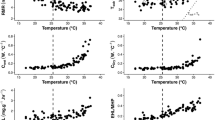Abstract
This study examines the ventilatory physiology of the numbat (Myrmecobius fasciatus), a small to medium-sized (550 g) termitivorous marsupial. Ventilatory parameters at thermoneutrality reflect the slightly low (83% of predicted) basal metabolic rate of the numbat, with ventilation frequency (ƒR; 30.6±3.65 breaths min−1), tidal volume [VT; 6.0±0.66 ml at body temperature and pressure, saturated (BTPS)] and consequently minute volume (VI; 117.7±15.22 ml min−1; BTPS) all being 80–87% of that expected for a marsupial of similar body mass. Oxygen extraction was 27.7±1.37% in the thermoneutral zone. As is typical of marsupials, numbats accommodated increased oxygen consumption rates at ambient temperatures (T a) below the thermoneutral zone by increasing minute volume (up to 411.2±43.98 ml min−1; BTPS at T a=10 °C) rather than oxygen extraction. Minute volume at 10 °C increased more by changes in ventilation frequency (up to 45.5±4.85 breaths min−1) than tidal volume (9.4±1.03 ml, BTPS), as is also typical for a small-medium sized marsupial.


Similar content being viewed by others
Abbreviations
- BMR :
-
basal metabolic rate
- BTPS :
-
body temperature and pressure, saturated
- EO 2 :
-
oxygen extraction
- ƒ R :
-
ventilation frequency
- STPD :
-
standard temperature and pressure, dry
- T a :
-
ambient temperature
- T b :
-
body temperature
- TNZ :
-
thermoneutral zone
- V I :
-
minute volume
- V T :
-
tidal volume
- V̇O 2 :
-
oxygen consumption rate
References
Archer M (1984) Vertebrate zoogeography and evolution in Australasia. In: Archer M, Clayton G (Eds) Vertebrate zoogeography and evolution in Australasia (animals in space and time). Hesperian, Carlisle, pp 633–808
Archer M, Kirsch JAW (1977) The case for the Thylacomyidae and Myrmecobiidae, Gill, 1972, or why are marsupial families so extended? Proc Lin Soc NSW 102:18–25
Baverstock PR, Krig M, Birrell J (1990) Evolutionary relationships of Australian marsupials as assessed by albumin immunology. Aust J Zool 37:273–288
Bucher TL (1985) Ventilation and oxygen consumption in Amazona viridigenalis. A reappraisal of ‘resting’ respiratory parameters in birds. J Comp Physiol B 155:269–276
Chappell MA (1985) Effects of ambient temperature and altitude on ventilation and gas exchange in deer mice (Peromyscus maniculatus). J Comp Physiol B 155:751–758
Chappell MA (1992) Ventilatory accommodation of changing oxygen demand in sciurid rodents. J Comp Physiol 162:722–730
Chappell MA, Dawson TJ (1994) Ventilatory accommodation of changing oxygen consumption in dasyurid marsupials. Physiol Zool 67:418–437
Cooper CE, Withers PC (2002) Metabolic physiology of the numbat (Myrmecobius fasciatus). J Comp Physiol B 172:669–675
Cooper CE, Withers PC, Bradshaw SD (2003) Field metabolic rate and water turnover of the numbat (Myrmecobius fasciatus). J Comp Physiol B 173:679–686
Dawson TJ, Hulbert AJ (1969) Standard energy metabolism of marsupials. Nature 221:383
Dawson TJ, Hulbert AJ (1970) Standard metabolism, body temperature and surface areas of Australian marsupials. Am J Physiol 218:1233–1238
Dawson TJ, Needham AD (1981) Cardiovascular characteristics of two resting marsupials: an insight into the cardio-respiratory allometry of marsupials. J Comp Physiol B 145:95–100
Dawson TJ, Munn AJ, Blaney CE, Krockenberger A, Maloney SK (2000) Ventilatory accommodation of oxygen demand and respiratory water loss in kangaroos from mesic and arid environments, the eastern grey kangaroo (Macropus giganteus) and the red kangaroo (Macropus rufus). Physiol Biochem Zool 73:382–388
Frappell PB, Baudinette RV (1995) Scaling of respiratory variables and the breathing pattern in adult marsupials. Respir Physiol 100:83–90
Hallam JF, Dawson TJ (1993) The pattern of respiration with increasing metabolism in a small dasyurid marsupial. Respir Physiol 93:305–314
Kirsch JAW (1968) Prodromus of the comparative serology of Marsupialia. Nature 217:418–420
Kleiber M (1932) Body size and animal metabolism. Hilgardia 6:315–353
Larcombe AN (2002) Effects of temperature on metabolism, ventilation and oxygen extraction in the southern brown bandicoot Isoodon obesulus (Marsupialia: Peramelidae). Physiol Biochem Zool 75:405–411
Malan A (1973) Ventilation measured by body plethysmography in hibernating mammals and in poikilotherms. Respir Physiol 17:32–44
Maloney SK, Dawson TJ (1994) Ventilatory accommodation of oxygen demand and respiratory water loss in a large bird, the emu (Dromaius novaehollandiae), and a re-examination of ventilatory allometry for birds. J Comp Physiol B 164:473–481
McNab BK (1984) Physiological convergence amongst ant-eating and termite-eating mammals. J Zool (Lond) 203:485–510
Nicol SC, Maskrey M (1980) Thermoregulation and sleep in the Tasmanian devil, Sarcophilus harrisii (Marsupialia: Dasyuridae). J Comp Physiol 140:241–248
Stahl WR (1966) Scaling of respiratory variables in mammals. J App Physiol:453–460
Withers PC (1977) Metabolic, respiratory and haematological adjustments of the little pocket mouse to circadian torpor cycles. Respir Physiol 31:295–307
Withers PC (2001) Design, calibration and calculation for flow-through respirometry systems. Aust J Zool 49:445–461
Withers PC, Casey TM, Casey KK (1979) Allometry of respiratory and haematological parameters of arctic mammals. Comp Biochem Physiol A 64:343–350
Withers PC, Thompson GG, Seymour RS (2000) Metabolic physiology of the northeastern marsupial mole, Notoryctes caurinus (Marsupialia: Notoryctidae). Aust J Zool 48:241–258
Acknowledgements
We are grateful to Perth Zoo, in particular Dr Terry Fletcher and staff of the Native Species Breeding Center for the use of the numbats and providing laboratory space, and to Alex Larcombe for his invaluable assistance. This study was approved by both the University of Western Australia and Perth Zoo animal ethics committees, and was supported by an APA to C. Cooper and the Australian Governments Cooperative Research Centers Program through the CRC for Conservation and Management of Marsupials.
Author information
Authors and Affiliations
Corresponding author
Additional information
Communicated by I.D. Hume
Rights and permissions
About this article
Cite this article
Cooper, C.E., Withers, P.C. Ventilatory physiology of the numbat (Myrmecobius fasciatus). J Comp Physiol B 174, 107–111 (2004). https://doi.org/10.1007/s00360-003-0394-0
Accepted:
Published:
Issue Date:
DOI: https://doi.org/10.1007/s00360-003-0394-0




